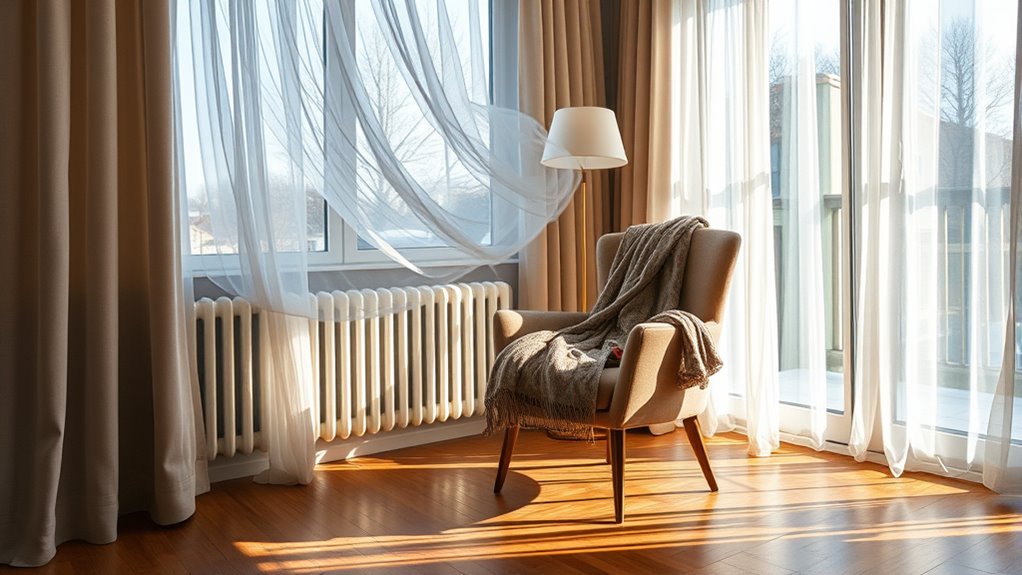The indoor wind-chill effect happens when airflow from drafts, vents, or open windows accelerates heat loss from your body and surroundings, making you feel colder even if the temperature stays the same. Moving air increases heat transfer through convection and evaporation, amplifying the sensation of coldness. Factors like poor insulation and drafts make this worse. If you keep exploring, you’ll discover practical ways to reduce wind-chill and stay comfortably warm indoors.
Key Takeaways
- Wind movement increases heat transfer from skin, making environments feel colder indoors despite stable temperatures.
- Airflow creates thermal drafts that disrupt indoor temperature balance and cause uneven warmth.
- Faster or turbulent airflow enhances convective heat loss, amplifying the wind-chill sensation inside buildings.
- Proper sealing and insulation reduce drafts, minimizing airflow and the associated cooling effects indoors.
- Managing airflow patterns and ventilation helps control perceived coldness and maintain indoor thermal comfort.
How Wind Movement Affects Indoor Temperatures

Even indoors, wind movement can markedly influence how warm or cool a room feels. Airflow patterns created by fans, open windows, or heating vents can generate thermal drafts that disrupt the room’s temperature balance. These drafts cause air to circulate unevenly, removing warm air from certain areas and replacing it with cooler air from elsewhere. As a result, you might notice spots that feel chillier despite the thermostat’s setting. Understanding how airflow patterns behave helps you identify cold spots and adjust your environment accordingly. Simple actions like closing drafts or repositioning vents can considerably reduce unwanted thermal drafts, making indoor spaces more comfortable. Recognizing the impact of wind movement indoors empowers you to optimize your home’s temperature and energy efficiency. Additionally, using top mattress toppers can help insulate your sleeping area against drafts, further enhancing comfort. Being aware of airflow dynamics allows you to better control indoor temperatures and improve overall comfort. Moreover, awareness of proper ventilation practices is essential to prevent dangerous gas buildup, such as carbon monoxide, especially around heating sources.
The Science Behind Perceived Cold and Airflow

Understanding why certain areas feel colder despite having the same temperature setting involves examining how airflow interacts with your skin. Thermal perception plays a key role here, influenced heavily by airflow dynamics. When air moves across your skin, it accelerates heat transfer away from your body, making you feel colder even if the actual temperature is unchanged. This sensation occurs because airflow increases evaporation and convective heat loss, which your brain interprets as a drop in temperature. The way air circulates—its speed, direction, and turbulence—directly impacts your perception of warmth or coldness. Additionally, the effects of airflow on thermal comfort can vary depending on environmental factors and individual sensitivity. Understanding how airflow patterns influence heat transfer can help you better grasp why airflow can make indoor environments feel notably cooler, even when thermostats indicate a stable temperature. Recognizing the thermal response to airflow can also guide you in optimizing indoor climate control for comfort.
Factors That Amplify the Indoor Wind-Chill Effect

Several factors can intensify the wind-chill effect indoors, making spaces feel colder than they actually are. One key factor is airflow patterns; when air moves rapidly across your skin or exposed surfaces, it increases heat loss. Poorly designed ventilation or drafts can create strong, directed airflow that amplifies this cooling sensation. In addition, airflow dynamics can influence how quickly cold air is circulated throughout a space, impacting the overall temperature perception. These dynamics are influenced by the air circulation system and the placement of vents, which can either mitigate or exacerbate the wind-chill effect. Insulation techniques also play a critical role. Inadequate insulation allows cold air to infiltrate walls, windows, and doors, leading to uneven temperature distribution and increased airflow near these areas. As a result, you experience a more pronounced wind-chill effect. To minimize this, you need to control airflow patterns and improve insulation, reducing drafts and slowing the movement of cold air within your indoor space. Additionally, adequate insulation can significantly reduce these effects by maintaining more consistent indoor temperatures.
Practical Implications for Indoor Comfort and Heating

To guarantee indoor comfort, managing the wind-chill effect is essential because it directly influences how warm a space feels regardless of the actual temperature. Effective thermal insulation reduces heat loss, minimizing the impact of wind-chill. Addressing window drafts plays a pivotal role, as they can create localized cold spots that amplify the chilling sensation. Consider these strategies:
- Seal gaps around windows and doors to prevent drafts.
- Use thermal curtains to add an extra layer of insulation.
- Enhance wall insulation to reduce overall heat loss.
- Install double-glazed windows to minimize cold air infiltration.
- Implement data-driven strategies to monitor and optimize indoor thermal performance. These approaches can help identify draft sources more precisely and improve overall heating efficiency. Additionally, understanding the security systems in place can aid in maintaining a stable indoor environment by preventing unauthorized access that could lead to temperature fluctuations.
Tips to Minimize Indoor Wind-Chill and Stay Warm

Controlling indoor wind-chill begins with practical steps you can take to block cold drafts and keep warm air in. Start by sealing gaps around windows and doors to reduce drafts, which directly affect thermal insulation. Adding weatherstripping or draft stoppers can make a noticeable difference. Enhancing your home’s thermal insulation, like installing thicker curtains or insulating walls, helps trap heat and minimizes heat loss. Consider using draft reduction measures such as door sweeps or draft blockers to prevent cold air from entering. Keep vents closed in unused rooms and ensure your heating system operates efficiently. These simple actions help maintain a stable indoor temperature, reduce wind-chill effects, and keep you comfortably warm without over-reliance on heating.
Frequently Asked Questions
How Does Indoor Humidity Influence the Wind-Chill Effect?
Indoor humidity influences the wind-chill effect by affecting how your skin loses heat. When humidity is low, air circulation speeds up heat loss, making you feel colder. Conversely, high humidity reduces this effect, as moisture in the air slows heat transfer. By controlling humidity levels, you can manage how cold you feel indoors. Proper humidity control and air circulation help maintain comfort and reduce the wind-chill sensation inside your home.
Can Indoor Plants Affect Airflow and Perceived Temperature?
You might notice indoor plants affecting airflow and perceived temperature through thoughtful plant placement. When you position plants near vents or open spaces, they can redirect airflow pathways, creating localized breezes or blocking drafts. This can make a room feel cooler or warmer depending on plant placement. By adjusting their location, you can optimize airflow, enhance comfort, and influence how warm or cool the room feels without changing the actual temperature.
What Role Do Building Materials Play in Indoor Wind-Chill?
Building materials play a key role in indoor wind-chill by affecting thermal insulation and material conductivity. When you choose materials with low conductivity, they slow heat transfer, keeping indoor temperatures stable and reducing cold drafts. Conversely, high-conductivity materials quickly transfer heat away, increasing wind-chill effects. By selecting well-insulating materials, you can improve comfort and minimize the wind-chill sensation indoors, especially in colder climates.
How Does Furniture Placement Impact Indoor Airflow and Comfort?
Did you know that poor furniture placement can reduce indoor airflow by up to 30%? You should consider ventilation strategies that promote better air circulation, making your space more comfortable. Proper furniture ergonomics ensures airflow isn’t obstructed, preventing cold spots and drafts. By strategically placing furniture, you can improve comfort, reduce energy costs, and create a healthier indoor environment. Small adjustments make a big difference in indoor airflow and overall coziness.
Are There Specific Architectural Designs That Reduce Indoor Wind-Chill?
You can reduce indoor wind-chill by choosing architectural designs that optimize thermal insulation and window placement. For example, incorporating well-insulated walls and strategically placing windows away from prevailing winds keeps warm air inside. Using double-glazed windows minimizes heat loss, while compact layouts decrease drafts. These features help maintain a cozy indoor environment, making you feel warmer and more comfortable, even in colder weather.
Conclusion
Now that you understand how indoor breezes can turn your cozy space into a chilly dance floor, you hold the power to tame the gusts. Think of yourself as a conductor, guiding the airflow to create harmony rather than chaos. With simple tips, you can turn your home into a warm haven, where the wind’s whispers are gentle rather than biting. Take control, and let comfort flow smoothly through every room you call your sanctuary.









